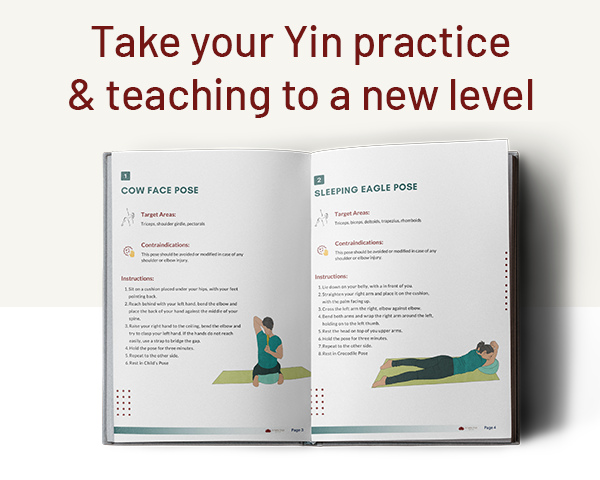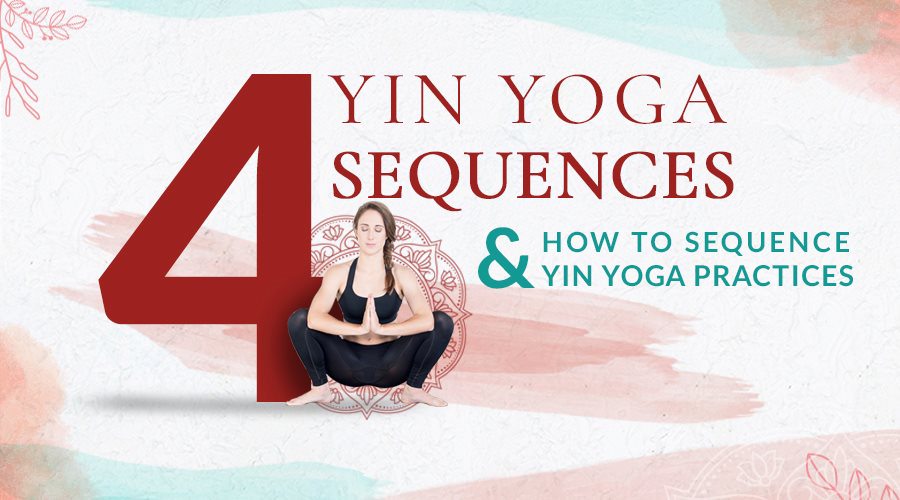A Yin Yoga sequence is basically a series of passive yoga poses held anywhere between three to 10 minutes. These Yin Yoga asanas stretch what we call the yin tissues. We usually hear about yin and yang. These are fundamental terms associated with Chinese philosophy of complementary forces. Yin tissues are deeper tissues such as the tendons, fascia, ligaments, and the other connective tissues of the body. Our yin tissues are less vascular (supplied with blood) and less elastic, and therefore need more time to stretch.
When stretched regularly, a Yin Yoga sequence can increase the overall flexibility, circulation, and range of motion of the joints and fascia. It's such a relief that you can learn how to use and practice a Yin Yoga sequence to complement your yang yoga practice.
Importantly, In Yin Yoga sequences the use of muscles is kept to a minimum. As the poses are to be held for a longer duration, the use of props like cushions and bolsters is essential. It is also very important to breathe correctly during a Yin Yoga sequence of asanas. The emphasis is on relaxed belly breathing. When we take long, slow, and deep breaths we allow our body to relax, enabling us to be in a pose for a longer duration of time.
What is the purpose of Yin Yoga sequences?
Indeed Yin Yoga might seem a little boring to some, as it does not require the dynamic movement as found in more active styles such as Hatha Yoga and Vinyasa Yoga. In these active yoga styles, the muscles receive the main load and stretch. Muscles are yang tissues; they are quick to warm up and stretch but also quick to cool down and rebound. That is why, if you don’t practice a few days, you see a big decline in flexibility and strength.
To explain further, if you practice only dynamic forms of exercise you can gain muscle strength, but not necessarily a wider range of motion. To have a healthy range of motion around our joints, we also need to stretch the deep connective tissue and our joints. This is why incorporating a Yin Yoga sequence into your practice is crucial to your overall flexibility and agility.
See - How to Practice Yoga Inversions Safely
It must be noted that Yin Yoga works deep into the connective tissues and activates rejuvenation at a deep level. A Yin Yoga sequence is a great practice if you are feeling stuck, stiff, or like you need to just pause and slow down. Also, a Yin Yoga sequence requires an intentional, slow pace. This means that Yin Yoga is great for beginners!
You also get to use props and ease into the pose, which means you can take your time and not feel under pressure trying to catch up with the rest of the class. While both Yin Yoga and Restorative Yoga are slow-paced and stress-relieving practices, they are very different. Yin is all about stretching and applying gentle stress to certain tissues. Restorative Yoga is all about supporting your body, allowing it to relax and heal.
Also Read - Yin Yoga versus Restorative Yoga
What are the benefits of Yin Yoga?
Physical benefits
The most important benefits can be summarized by understanding the effect on the following tissues:
Fascia – With the long holds, we stretch and stimulate the layers of fascia in our body. With regular stress, our fascia becomes subtle, and the flow of nutrients increases. This results in the improved overall functioning of the body.
Ligaments – Our ligaments connect bones to bones. Ligaments are stiff and strong fascial bands that protect our joints from going out of place, and therefore, limit our range of motion. But ligaments are always contracting with age. With Yin Yoga, we gently stretch our ligaments and maintain the range of motion of our joints. In other words, we stay younger by stretching our ligaments.
Tendons – Our tendons are the connective tissue that connects muscle to the bone. With yang exercises, the tendons become strong and short. This results in a decreased range of motion of the tendons. This is the top reason for injury in athletes. With yin poses, we pressure and lengthen the tendons gently and retain their range of motion.
Joints – All physical movement happens at our joints. But due to the modern lifestyle which promotes a lack of movement and short-range movements, the fluids in the joint capsules decrease. This decreases the lifespan of the joint. With Yin Yoga, we put gentle pressure on the joints, which revitalizes the joints and renews the fluids.
Viscera – With gentle and long pressure on our internal organs, we stimulate them and improve their functioning.
Myofascial – As the quality of the connective tissue is improved, the range of flexibility in our muscles (myofascial) is also positively affected.
Mental benefits
Stress release – It helps to release stress which is stored in our deeper tissues. That is why you will often see people getting emotional or silently crying during classes. You should know that such reactions are completely normal and can be, in fact, expected.
Emotional balance – It stimulates our endocrine glands by pressuring them during the long-held poses. The effect is an improved hormonal balance which results in more balanced emotions.
Clarity – There is power in stillness. The regular practice of sitting still and focusing brings mental clarity.
Another great benefit of Yin Yoga is its benefits for those who suffer from migraines. Yin Yoga can help prevent migraines.
How to create a Yin Yoga sequence
As mentioned before, the aim of a Yin Yoga sequence is to stretch and stress certain yin tissue of the body. A Yin Yoga sequence allows the entire nervous system to calm down and the mind to experience relaxation and restoration. However, keep in mind that an improper yoga sequence can result in too much stress on a particular joint or region. There are no fixed rules for creating a Yin Yoga class sequence. But let me share with you some pointers that can help you create balanced sequences.
Remember, in Yin Yoga the aim is to find the space just before your “edge.” This means that you may feel a certain stress and discomfort, but you are not in pain. If you do, slowly back away and find that space before your edge; how far you can go to feel comfortable discomfort. Also, in a Yin Yoga sequence, the body is to remain cool so that we can stretch the connective tissue rather than the muscles. This is another reason to take it slow, to keep to your edge and to remember to relax during a Yin Yoga sequence!
Want more tips? Read the blog: Teaching Yin Yoga: 10 Tips for Teachers

Get the illustrated e-book 10 Yin Yoga Poses for the Upper Body by Ram Jain for free
If you are interested in completing a Yin Yoga teacher training course or are a qualified teacher, there are some helpful tips to provide a successful and safe Yin Yoga sequence for your students. Here are a few tips:
- A Yin Yoga sequence can be 60, 75 or 90 minutes in duration.
- Set a goal or theme for the class in advance.
- Incorporate some gentle soothing breathing exercises before the class.
- Try to balance the number of back-bends and forward-bends in a Yin Yoga sequence.
- Build up the class for deep hip openers or forward bends. You can do this by starting the class Yin Yoga sequence with more gentle yin poses and then gradually increasing the intensity of the poses.
- Try to combine poses in a flow to reduce the changes of body positions.
- Always do and hold the yin pose on both left and right sides for equal time.
- Sometimes, it may be more beneficial in a Yin Yoga sequence to use another yin pose as a counter pose instead of using a resting pose.
- Allow enough time for transitions, explanations and assisting with props.
Four Yin Yoga sequences for self-practice or teaching
Theme: Yin Yoga sequence for the legs and spine
Duration: 60 minutes | |
|---|---|
Cat Pulling its Tail | 5 minutes each side |
Half Butterfly | 5 minutes each side |
Caterpillar | 5 minutes each side |
Corpse Pose | 2 min. |
Sphinx | 3 min. |
Seal | 2 min. |
Dragonfly | 5 min. |
Snail | 5 min. |
Final Relaxation | 10 min. |
Theme: Yin Yoga sequence for stress release
Duration: 75 minutes | |
|---|---|
Child Pose | 5 min. |
Butterfly | 5 min. |
Cat Pulling its Tail | 5 min. each side |
Caterpillar | 5 min. |
Bridge | 5 min. |
Dragonfly | 5 min. |
Deer | 5 min. each side |
Sphinx | 5 min. |
Relaxation | 10 min. |
Theme: Yin Yoga sequence for the groin and lower spine
Duration: 75 minutes | |
|---|---|
Butterfly | 5 min. |
Lying Twist | 5 min. each side |
Half Butterfly | 5 min. each side |
Half Saddle | 5 min. each side |
Sleeping Swan | 5 min. each side |
Caterpillar | 5 min. |
Dragonfly | 5 min. each side |
Frog | 5 min. |
Final Relaxation | 10 min. |
Theme: Yin Yoga sequence for the whole body
Duration: 75 minutes | |
|---|---|
Child Pose | 5 min. |
Caterpillar | 5 min. |
Dragon | 5 min. each side |
Sphinx | 5 min. |
Seal | 3 min. |
Frog | 5 min. |
Cat Pulling its Tail | 5 min. each side |
Sleeping Swan | 5 min. each side |
Dragonfly | 5 min. |
Shoelace | 3 min. each side |
Banana | 3 min. each side |
Final Relaxation | 10 min. |
In Yin Yoga, you can learn to take change slowly and move at your pace. This is deeply respectful to body and mind. Keep to that space just before your edge where you can still feel bodily discomforts yet stay in that pose for a prolonged period of time. A Yin Yoga sequence may be just what you need to transform your body; improve your flexibility and calm your mind, in a different way!
You may become aware of time passing in the pose, but you’re never stuck. Adjust or come out of the pose at any time. Trust that no effort to get into the postures and no amount of time in them is wasted.

Get the illustrated e-book 10 Yin Yoga Poses for the Upper Body by Ram Jain for free

